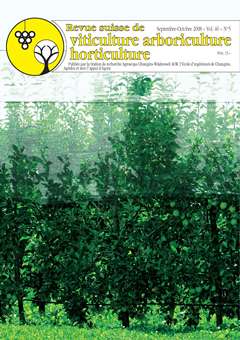
Issue 5 - September - October 2008
Abstract in open access
An apricot breeding programme started in 2001 at Agroscope Changins-Wädenswil ACW. The overall goal of this programme was the finding of interesting varieties to replace cv. Luizet, characterised by rapid post-harvest ripening no more required by the market. However, its very good adaptation to the local soil and climatic conditions and excellent flavour make of Luizet an ideal basis for a breeding programme. Six promising hybrids have been preselected for their agronomical, commercial and gustative qualities. They are characterised by early ripening time and regular production over the years. Furthermore, a consumer test revealed a better fruit quality than that of the control Orangered®. Hybrids FG 4118 and FG 4136 were chosen among all for their more regular production and excellent fruit quality. These two selections will soon be commercialised by VariCom Ltd, the marketing company for new ACW varieties.
Keywords: breeding programme, selection, apricot, yield, fruit quality, Switzerland.
E-Mail: danilo.christen@agroscope.admin.ch
Adress: Agroscope, 1964 Conthey
Abstract in open access
Basic conditions for plant production in Switzerland will be substantially different by 2050, mainly by increased competition in global and free markets, climate change causing more frequent disasters, and by scarcity of resources: soil quality will diminish, arable land will disappear and water will no longer be constantly available. Is plant production in Switzerland still feasible and expedient under these circumstances? What are the requirements for plant production in the future? Experts in plant sciences addressed these questions during the project «Perspectives for Plant Production 2050» of the Swiss Society of Agronomy (SSA). The conclusions of the study showed that the sufficient production of high quality food is only possible based on scientific and technological progress in plant sciences and production. In addition, conservation of fertile agricultural land and public commodities such as recreational landscapes, secure supply of drinking water and conservation of biodiversity are a necessity. The SSA highlights the requirements for research and development for enabling plant production of high quality and quantity in the future.
Keywords: plant production, 2050, perspectives, climate change, scarcity of resources, changed basic conditions.
E-Mail:
Adress: Agora
Abstract in open access
Shading with nets of 2m and 3m width respectively, which reduce the photosynthetic active radiation by 74%, lead to successful fruit thinning of apple trees. Such a thinning method could be interesting for organic as well as for integrated production. Field trials in 2006 and 2007 with the cultivars Golden Delicious, Elstar and Topaz showed that this thinning method regulated the crop load to the necessary extent and that the achieved fruit quality is acceptable. However, cultivars respond differently to the length of shading. Three days of shading reduced fruits per 100 flower clusters to a satisfactory extent for Golden Delicious (if shading after 19, 26 and 33 days after full bloom) and Topaz (if shading after 19 and 26 days after full bloom). For Elstar, seven days shading at 25 days after full bloom resulted in a good thinning effect. Flower counts in the following year showed a reduction of alternate bearing in the shaded trees. The results obtained demonstrate that the response of the method to meteorological conditions seems to be surprisingly low. Date and length of shading seems to be more important. Practicability of the method in farmers’ orchards has yet to be improved, however. Net installation is still too costly and time-consuming, therefore easy to handle and cheap methods must be developed. The European ISAFRUIT-project made these studies possible by providing the necessary international collaborative research network and the funding.
Keywords: apple, thinning, alternate bearing, shading net, crop load.
E-Mail:
Adress: Agora
Abstract in open access
A storage trial with the apple cultivar Golden Orange was conducted during three years. The first aim of this study was to test the influence of 1-methylcyclopropene (1-MCP) under three storage conditions: NA (normal atmosphere), CA (controlled atmosphere) and ULO (Ultra Low Oxygen). Secondly the optimal harvest window was to be defined. Following values are now proposed: sugar 12 to 13% Brix, firmness 8 to 9 kg, starch 4 to 6, malic acid 7 to 8.5 g/l and Streif index 0.102 to 0.187. ULO conditions or 1-MCP applications were effective to avoid superficial scald development. 1-MCP treatment under ULO atmosphere was the best condition to maintain an ideal apple quality for long storage period (until the end of May). Firmness and malic acid remain high, as well as taste quality of the apples.
Keywords: storage, 1-MCP, ULO, Golden Orange, controlled atmosphere, quality, scald.
E-Mail: jean-sebastien.reynard@acw.admin.ch
Adress: Agora
Abstract in open access
The bleuet du Lac Saint-Jean (wild blueberry) is considered as a potential Protected Designation of Origin (PDO product) in Québec, thanks to its great reputation and territorial roots. Today, nearly the entire production of this wild blueberry is frozen by two local companies. They also ensure with success its marketing on the international bulk market under the name wild blueberry or boreal blueberry. The interest of the supply chain actors in the registration of bleuet du Lac Saint-Jean is divided. Nevertheless, the creation of an alternative supply chain that would sell the PDO product on a niche market in parallel to the bulk market could have positive economic, social and environmental impacts for the region.
Keywords: bleuet du Lac Saint-Jean, Québec, wild blueberry, protected designation of origin, PDO.
E-Mail:
Adress: Agora

 Download of full issue
Download of full issue
 Download article
Download article